Evaluating the Capability of Sentinel-1 Data in the Classification of Canola and Wheat at Different Growth Stages and in Different Years
Abstract
1. Introduction
2. Study Area and Dataset
2.1. Study Area
2.2. SAR Data
2.3. Auxiliary Data and Ground Reference Data
3. Methodology
3.1. Segmentation of Fields by Sentinel-2 Images
3.2. Random Forest Classification and Accuracy Assessment
4. Results and Analysis
4.1. Backscattering Analysis of Canola and Wheat
4.1.1. Backscattering Profiles of Canola
4.1.2. Backscattering Profiles of Wheat
4.2. Classification Results of Canola and Wheat on Single-Temporal Images
4.3. Classification Results of Canola and Wheat Using Multi-Temporal Images
4.4. Feature Importance Analysis
5. Conclusions
Author Contributions
Funding
Data Availability Statement
Acknowledgments
Conflicts of Interest
References
- USDA. Oilseeds: World Markets and Trade. Available online: https://downloads.usda.library.cornell.edu/usda-esmis/files/tx31qh68h/6395wv88t/8g84n812b/oilseeds.pdf (accessed on 7 August 2022).
- USDA. Grain: World Markets and Trade. Available online: https://www.fas.usda.gov/data/grain-world-markets-and-trade (accessed on 7 August 2022).
- Daily, G.; Dasgupta, P.; Bolin, B.; Crosson, P.; Guerny, J.D.; Ehrlich, P.; Folke, C.; Jansson, A.M.; Jansson, B.-O.; Kautsky, N.; et al. Food production, population growth, and the environment. Science 1998, 281, 1291–1292. [Google Scholar] [CrossRef] [PubMed]
- Kussul, N.; Lemoine, G.; Gallego, F.J.; Skakun, S.V.; Lavreniuk, M.; Shelestov, A.Y. Parcel-based crop classification in Ukraine using Landsat-8 data and Sentinel-1A data. IEEE J. Sel. Top. Appl. Earth Obs. Remote Sens. 2016, 9, 2500–2508. [Google Scholar] [CrossRef]
- Larrañaga, A.; Álvarez-Mozos, J. On the added value of quad-pol data in a multi-temporal crop classification framework based on RADARSAT-2 Imagery. Remote Sens. 2016, 8, 335. [Google Scholar] [CrossRef]
- Manfron, G.; Delmotte, S.; Busetto, L.; Hossard, L.; Ranghetti, L.; Brivio, P.A.; Boschetti, M. Estimating inter-annual variability in winter wheat sowing dates from satellite time series in Camargue, France. Int. J. Appl. Earth Obs. Geoinf. 2017, 57, 190–201. [Google Scholar] [CrossRef]
- Moran, M.S.; Inoue, Y.; Barnes, E.M. Opportunities and limitations for image-based remote sensing in precision crop management. Remote Sens. Environ. 1997, 61, 319–346. [Google Scholar] [CrossRef]
- Nguyen, L.H.; Robinson, S.; Galpern, P. Medium-resolution multispectral satellite imagery in precision agriculture: Mapping precision canola (Brassica napus L.) yield using Sentinel-2 time series. Precis. Agric. 2022, 23, 1051–1071. [Google Scholar] [CrossRef]
- Campos, I.; González-Gómez, L.; Villodre, J.; Calera, M.; Campoy, J.; Jiménez, N.; Plaza, C.; Sánchez-Prieto, S.; Calera, A. Mapping within-field variability in wheat yield and biomass using remote sensing vegetation indices. Precis. Agric. 2018, 20, 214–236. [Google Scholar] [CrossRef]
- Qiu, B.; Luo, Y.; Tang, Z.; Chen, C.; Lu, D.; Huang, H.; Chen, Y.; Chen, N.; Xu, W. Winter wheat mapping combining variations before and after estimated heading dates. ISPRS J. Photogramm. Remote Sens. 2017, 123, 35–46. [Google Scholar] [CrossRef]
- Ashourloo, D.; Shahrabi, H.S.; Azadbakht, M.; Aghighi, H.; Nematollahi, H.; Alimohammadi, A.; Matkan, A.A. Automatic canola mapping using time series of sentinel 2 images. ISPRS J. Photogramm. Remote Sens. 2019, 156, 63–76. [Google Scholar] [CrossRef]
- Sulik, J.J.; Long, D.S. Spectral indices for yellow canola flowers. Int. J. Remote Sens. 2015, 36, 2751–2765. [Google Scholar] [CrossRef]
- Sulik, J.J.; Long, D.S. Spectral considerations for modeling yield of canola. Remote Sens. Environ. 2016, 184, 161–174. [Google Scholar] [CrossRef]
- Arias, M.; Campo-Bescós, M.Á.; Álvarez-Mozos, J. Crop classification based on temporal signatures of Sentinel-1 observations over Navarre Province, Spain. Remote Sens. 2020, 12, 278. [Google Scholar] [CrossRef]
- Wang, H.; Magagi, R.; Goïta, K.; Trudel, M.; McNairn, H.; Powers, J. Crop phenology retrieval via polarimetric SAR decomposition and Random Forest algorithm. Remote Sens. Environ. 2019, 231, 111234. [Google Scholar] [CrossRef]
- d’Andrimont, R.; Taymans, M.; Lemoine, G.; Ceglar, A.; Yordanov, M.; van der Velde, M. Detecting flowering phenology in oil seed rape parcels with Sentinel-1 and -2 time series. Remote Sens. Environ. 2020, 239, 111660. [Google Scholar] [CrossRef]
- Wang, Y.; Fang, S.; Zhao, L.; Huang, X.; Jiang, X. Parcel-based summer maize mapping and phenology estimation combined using Sentinel-2 and time series Sentinel-1 data. Int. J. Appl. Earth Obs. Geoinf. 2022, 108, 102720. [Google Scholar] [CrossRef]
- Canisius, F.; Shang, J.; Liu, J.; Huang, X.; Ma, B.; Jiao, X.; Geng, X.; Kovacs, J.M.; Walters, D. Tracking crop phenological development using multi-temporal polarimetric Radarsat-2 data. Remote Sens. Environ. 2018, 210, 508–518. [Google Scholar] [CrossRef]
- Skriver, H.; Svendsen, M.T.; Thomsen, A.G. Multitemporal C- and L-band polarimetric signatures of crops. IEEE Trans. Geosci. Remote Sens. 1999, 37, 2413–2429. [Google Scholar] [CrossRef]
- Skriver, H. Crop Classification by Multitemporal C- and L-Band Single- and Dual-Polarization and Fully Polarimetric SAR. IEEE Trans. Geosci. Remote Sens. 2012, 50, 2138–2149. [Google Scholar] [CrossRef]
- McNairn, H.; Jiali, S.; Xianfeng, J.; Champagne, C. The contribution of ALOS PALSAR multipolarization and polarimetric data to crop classification. IEEE Trans. Geosci. Remote Sens. 2009, 47, 3981–3992. [Google Scholar] [CrossRef]
- Shi, L.; Zhang, L.; Zhao, L.; Yang, J.; Li, P.; Zhang, L. The potential of linear discriminative Laplacian eigenmaps dimensionality reduction in polarimetric SAR classification for agricultural areas. ISPRS J. Photogramm. Remote Sens. 2013, 86, 124–135. [Google Scholar] [CrossRef]
- Xie, Q.; Wang, J.; Liao, C.; Shang, J.; Lopez-Sanchez, J.; Fu, H.; Liu, X. On the use of neumann decomposition for crop classification using multi-temporal RADARSAT-2 polarimetric SAR data. Remote Sens. 2019, 11, 776. [Google Scholar] [CrossRef]
- Jiao, X.; Kovacs, J.M.; Shang, J.; McNairn, H.; Walters, D.; Ma, B.; Geng, X. Object-oriented crop mapping and monitoring using multi-temporal polarimetric RADARSAT-2 data. ISPRS J. Photogramm. Remote Sens. 2014, 96, 38–46. [Google Scholar] [CrossRef]
- Tamiminia, H.; Homayouni, S.; McNairn, H.; Safari, A. A particle swarm optimized kernel-based clustering method for crop mapping from multi-temporal polarimetric L-band SAR observations. Int. J. Appl. Earth Obs. Geoinf. 2017, 58, 201–212. [Google Scholar] [CrossRef]
- Wiseman, G.; McNairn, H.; Homayouni, S.; Shang, J. RADARSAT-2 Polarimetric SAR response to crop biomass for agricultural production monitoring. IEEE J. Sel. Top. Appl. Earth Obs. Remote Sens. 2014, 7, 4461–4471. [Google Scholar] [CrossRef]
- Gella, G.W.; Bijker, W.; Belgiu, M. Mapping crop types in complex farming areas using SAR imagery with dynamic time warping. ISPRS J. Photogramm. Remote Sens. 2021, 175, 171–183. [Google Scholar] [CrossRef]
- Zhao, L.; Yang, J.; Li, P.; Shi, L.; Zhang, L. Characterizing lodging damage in wheat and canola using Radarsat-2 polarimetric SAR data. Remote Sens. Lett. 2017, 8, 667–675. [Google Scholar] [CrossRef]
- Brown, S.C.M.; Quegan, S.; Morrison, K.; Bennett, J.C.; Cookmartin, G. High-resolution measurements of scattering in wheat canopies-implications for crop parameter retrieval. IEEE Trans. Geosci. Remote Sens. 2003, 41, 1602–1610. [Google Scholar] [CrossRef]
- Zhao, L.; Jie, Y.; Li, P.; Zhao, J.; Yuan, Z. Detection of the lodged area of wheat by the use of radarsat-2 polarimetric sar imagery. In Proceedings of the IGARSS 2017—2017 IEEE International Geoscience and Remote Sensing Symposium, Forth Worth, TX, USA, 23–28 July 2017. [Google Scholar]
- Bhogapurapu, N.; Dey, S.; Bhattacharya, A.; Mandal, D.; Lopez-Sanchez, J.M.; McNairn, H.; López-Martínez, C.; Rao, Y.S. Dual-polarimetric descriptors from Sentinel-1 GRD SAR data for crop growth assessment. ISPRS J. Photogramm. Remote Sens. 2021, 178, 20–35. [Google Scholar] [CrossRef]
- Mandal, D.; Kumar, V.; Ratha, D.; Dey, S.; Bhattacharya, A.; Lopez-Sanchez, J.M.; McNairn, H.; Rao, Y.S. Dual polarimetric radar vegetation index for crop growth monitoring using sentinel-1 SAR data. Remote Sens. Environ. 2020, 247, 111954. [Google Scholar] [CrossRef]
- Schlund, M.; Erasmi, S. Sentinel-1 time series data for monitoring the phenology of winter wheat. Remote Sens. Environ. 2020, 246, 111814. [Google Scholar] [CrossRef]
- Geudtner, D.; Torres, R.; Snoeij, P.; Davidson, M.; Rommen, B. Sentinel-1 system capabilities and applications. In Proceedings of the IGARSS 2014—2014 IEEE International Geoscience and Remote Sensing Symposium, Quebec City, QC, Canada, 13–18 July 2014. [Google Scholar]
- Lee, J.S.; Grunes, M.R.; De Grandi, G. Polarimetric SAR speckle filtering and its implication for classification. IEEE Trans. Geosci. Remote Sens. 2002, 37, 2363–2373. [Google Scholar]
- Chen, J.; Cao, X.; Peng, S.; Ren, H. Analysis and applications of Globeland30: A review. ISPRS Int. J. Geo-Inf. 2017, 6, 230. [Google Scholar] [CrossRef]
- Achanta, R.; Susstrunk, S. Superpixels and polygons using simple non-iterative clustering. In Proceedings of the 2017 IEEE Conference on Computer Vision and Pattern Recognition (CVPR), Honolulu, HI, USA, 21–26 July 2017; pp. 4895–4904. [Google Scholar]
- Breiman, L. Random Forests. Mach. Learn. 2001, 45, 5–32. [Google Scholar] [CrossRef]
- Mercier, A.; Betbeder, J.; Baudry, J.; Le Roux, V.; Spicher, F.; Lacoux, J.; Roger, D.; Hubert-Moy, L. Evaluation of Sentinel-1 & 2 time series for predicting wheat and rapeseed phenological stages. ISPRS J. Photogramm. Remote Sens. 2020, 163, 231–256. [Google Scholar] [CrossRef]
- Bargiel, D. A new method for crop classification combining time series of radar images and crop phenology information. Remote Sens. Environ. 2017, 198, 369–383. [Google Scholar] [CrossRef]
- Hripcsak, G.; Rothschild, A.S. Agreement, the f-measure, and reliability in information retrieval. J. Am. Med. Inform. Assoc. 2005, 12, 296–298. [Google Scholar] [CrossRef]
- Zhao, L.; Yang, J.; Li, P.; Zhang, L. Characteristics analysis and classification of crop harvest patterns by exploiting high-frequency multipolarization SAR data. IEEE J. Sel. Top. Appl. Earth Obs. Remote Sens. 2014, 7, 3773–3783. [Google Scholar] [CrossRef]
- Deschamps, B.; McNairn, H.; Shang, J.; Jiao, X. Towards operational radar only crop type classification comparison of a traditional decision tree with a random forest classifier. Can. J. Remote Sens. 2012, 38, 60–68. [Google Scholar] [CrossRef]
- Veloso, A.; Mermoz, S.; Bouvet, A.; Le Toan, T.; Planells, M.; Dejoux, J.-F.; Ceschia, E. Understanding the temporal behavior of crops using Sentinel-1 and Sentinel-2-like data for agricultural applications. Remote Sens. Environ. 2017, 199, 415–426. [Google Scholar] [CrossRef]
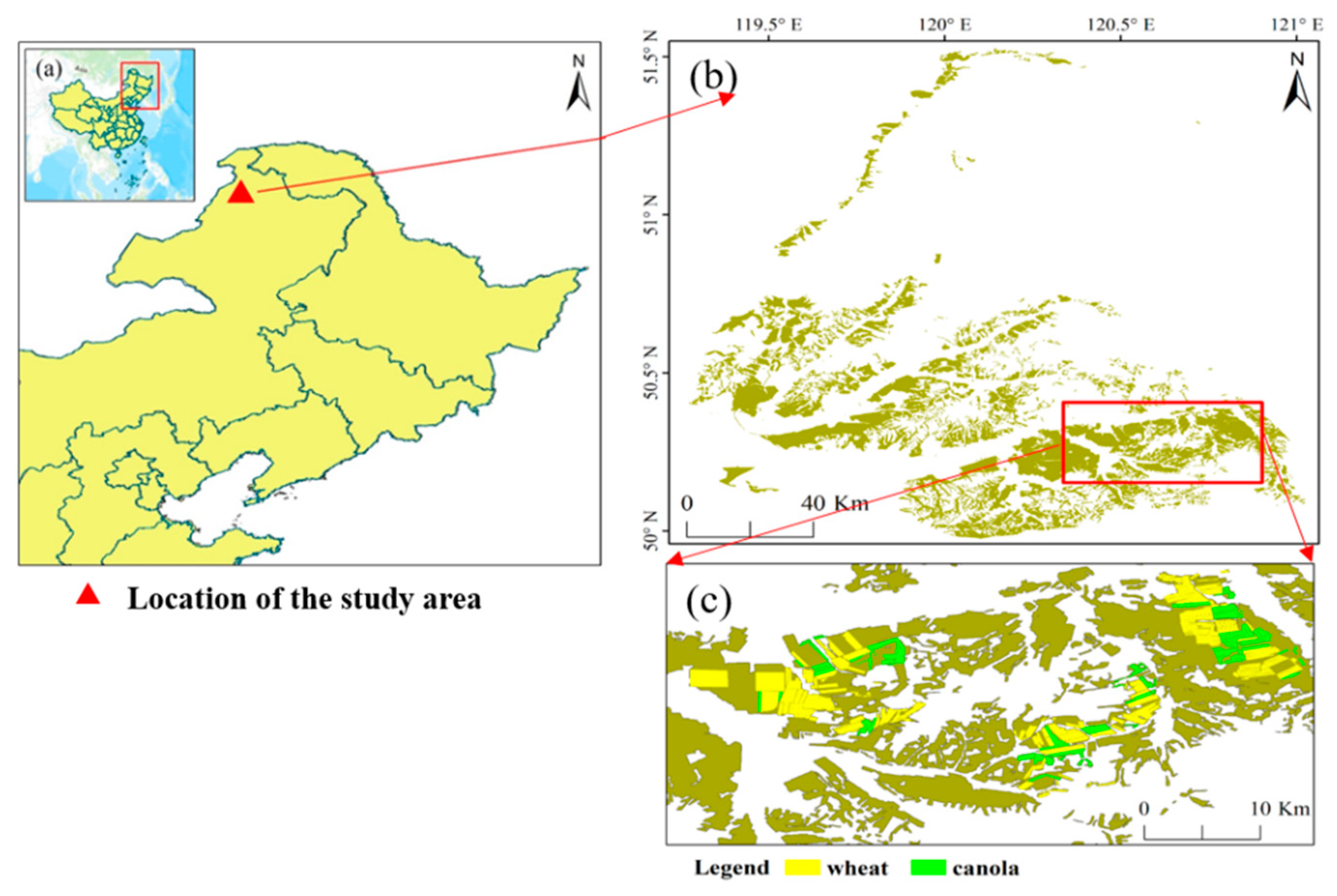

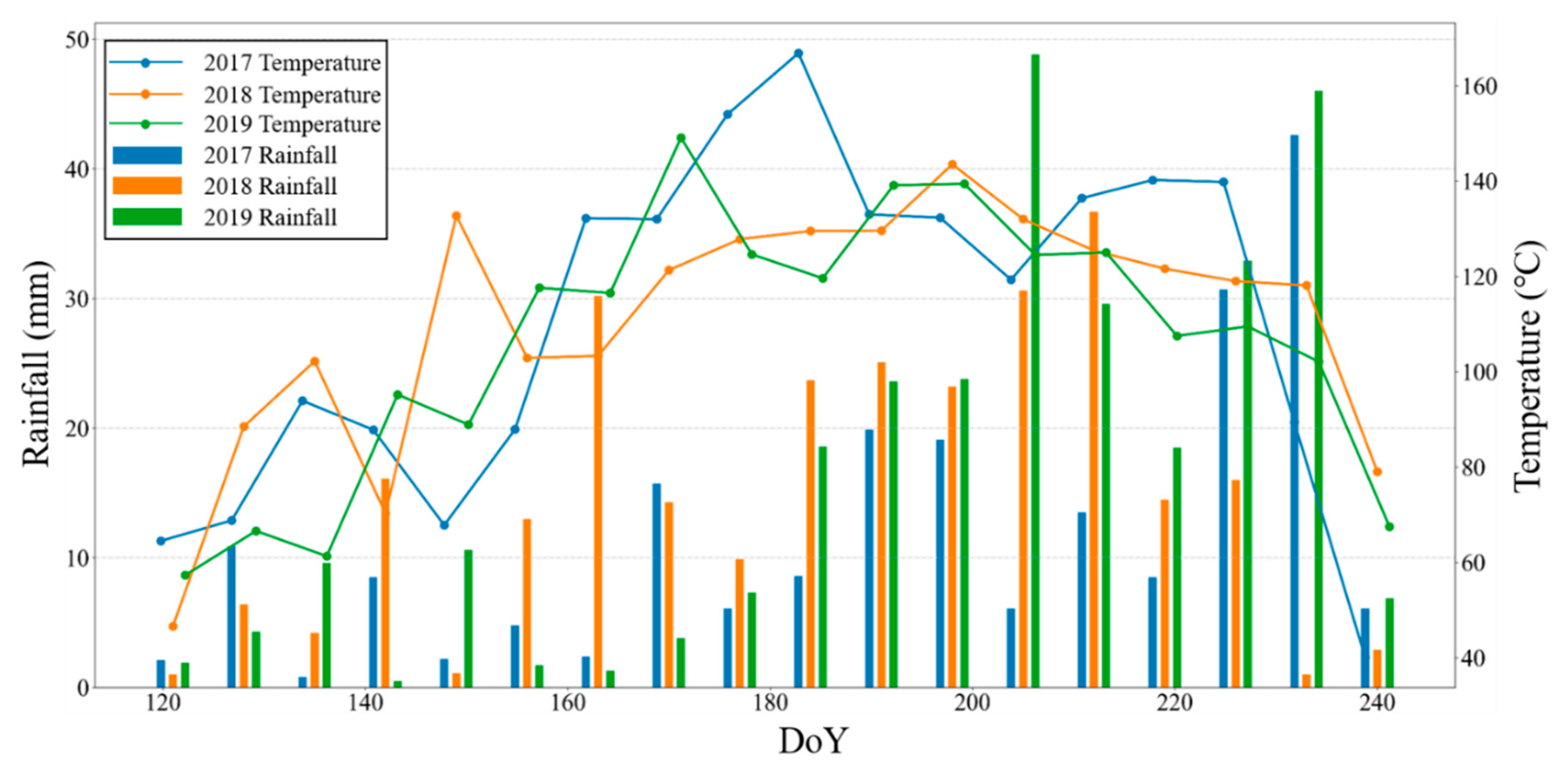

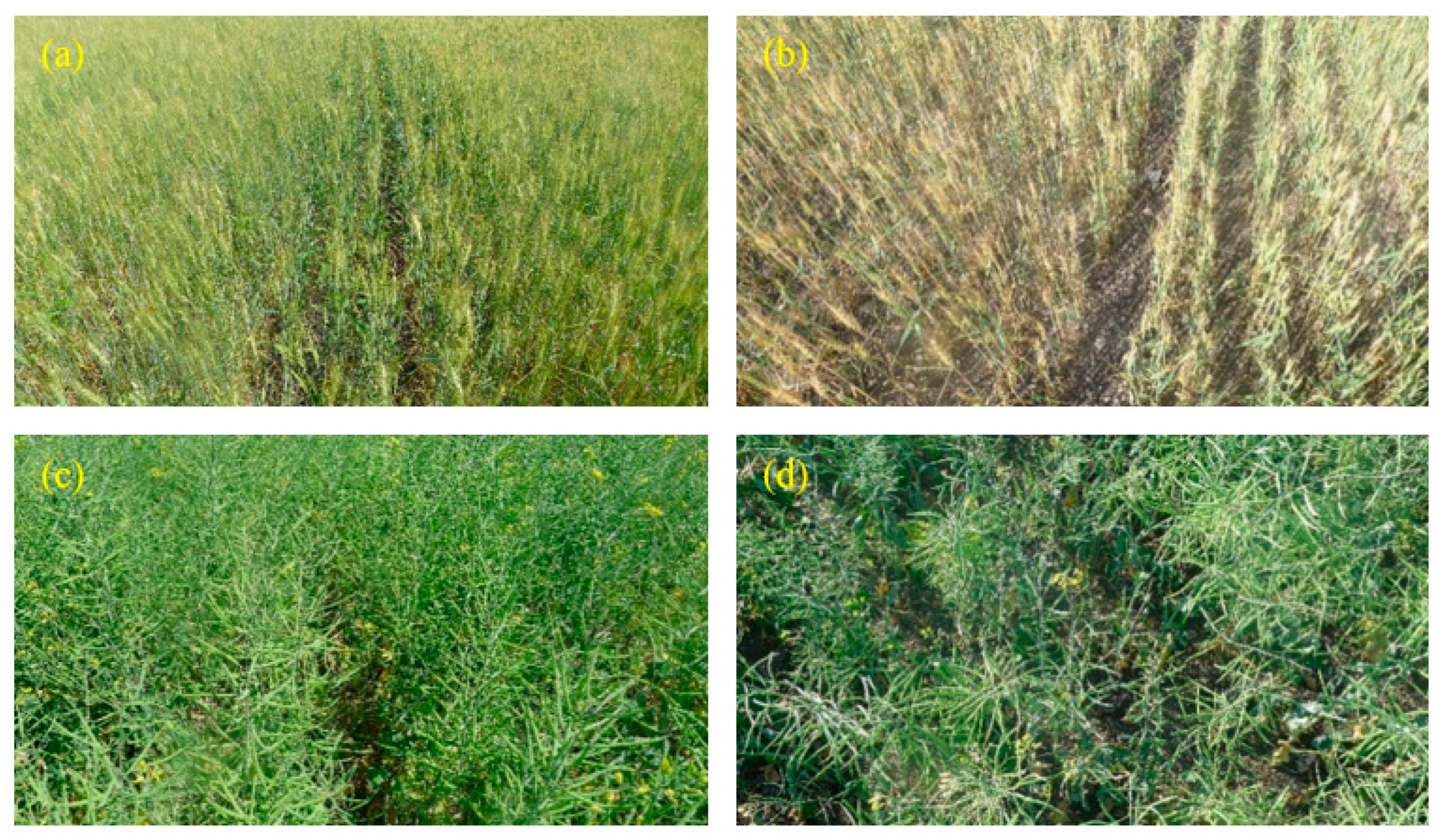
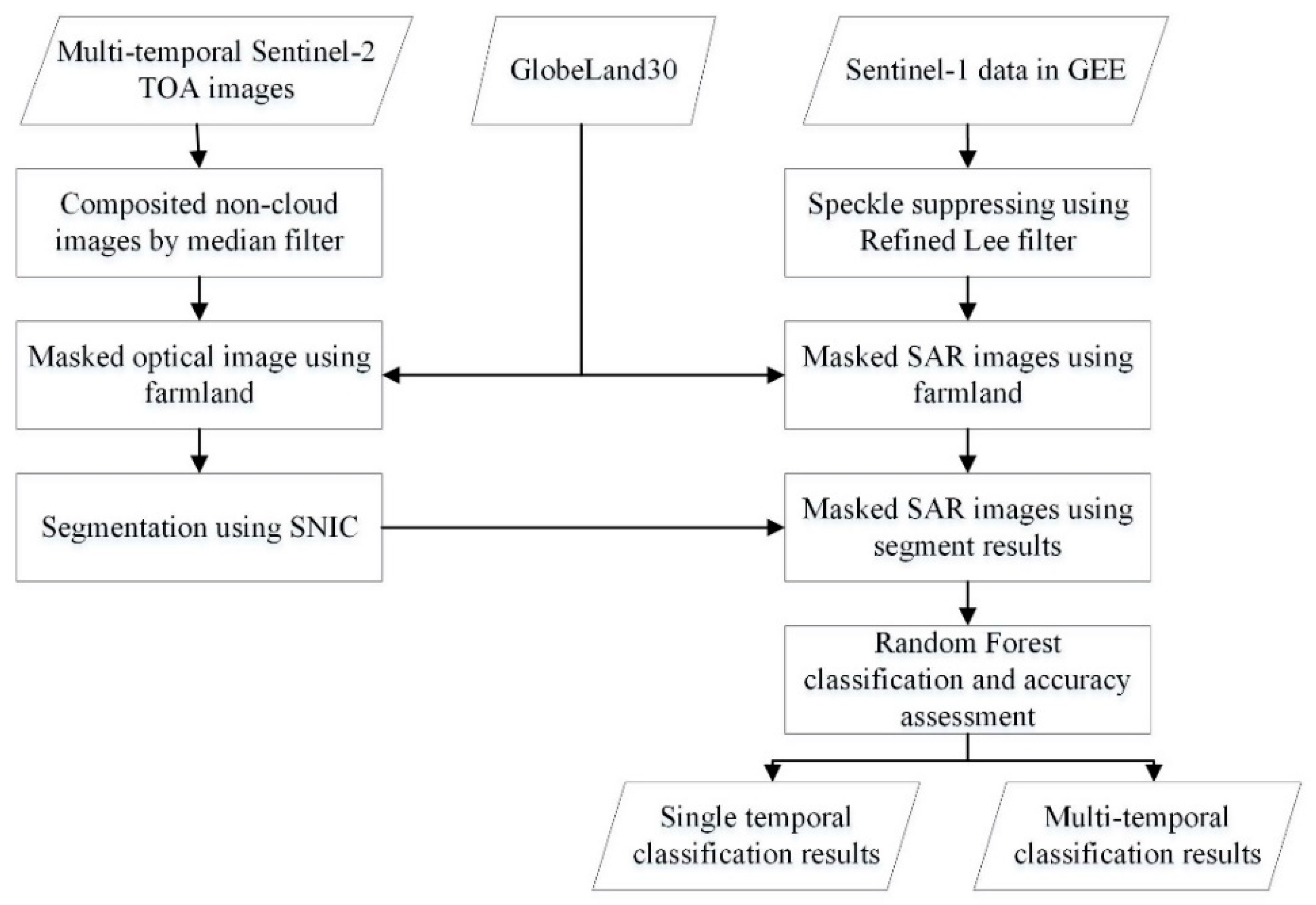
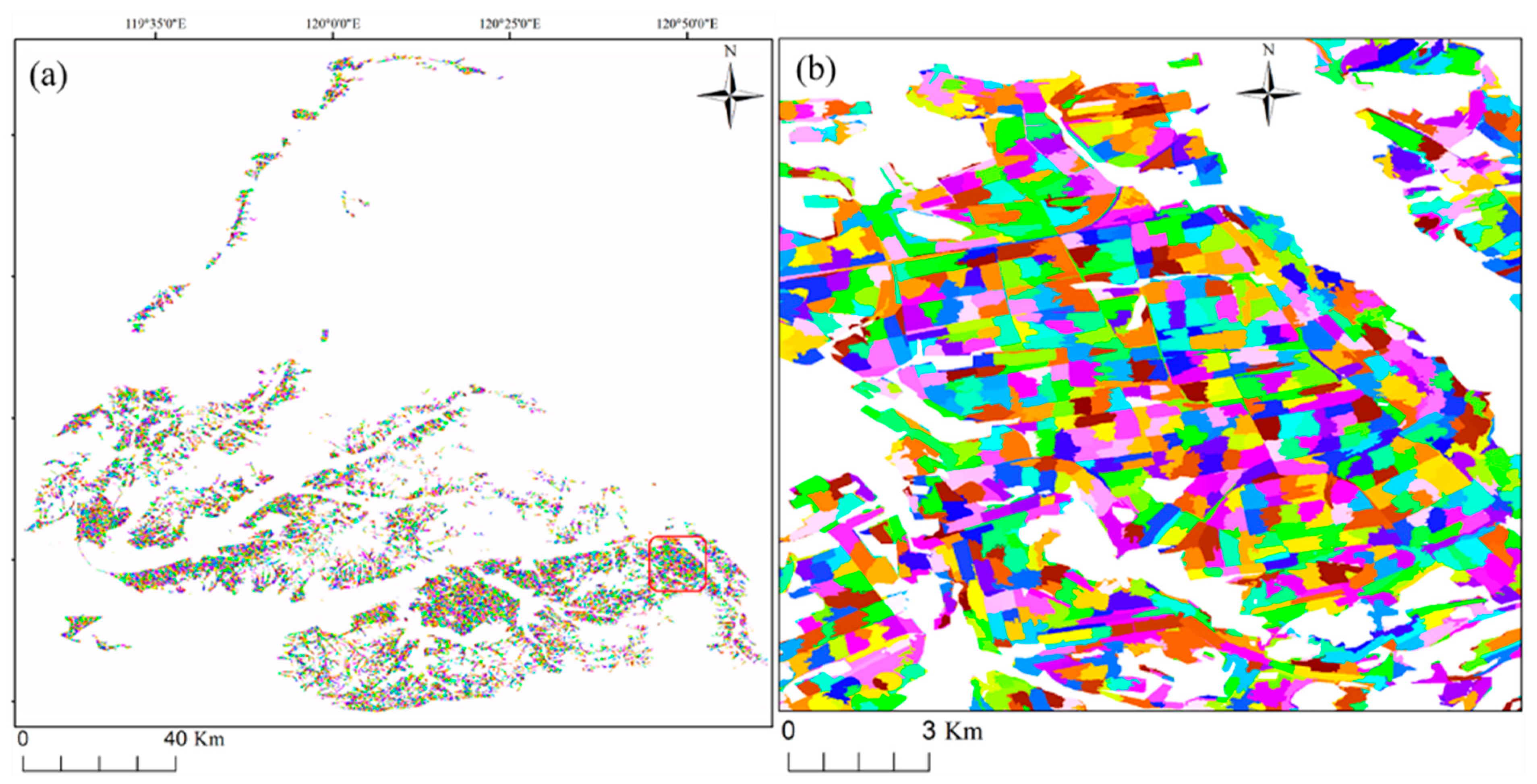

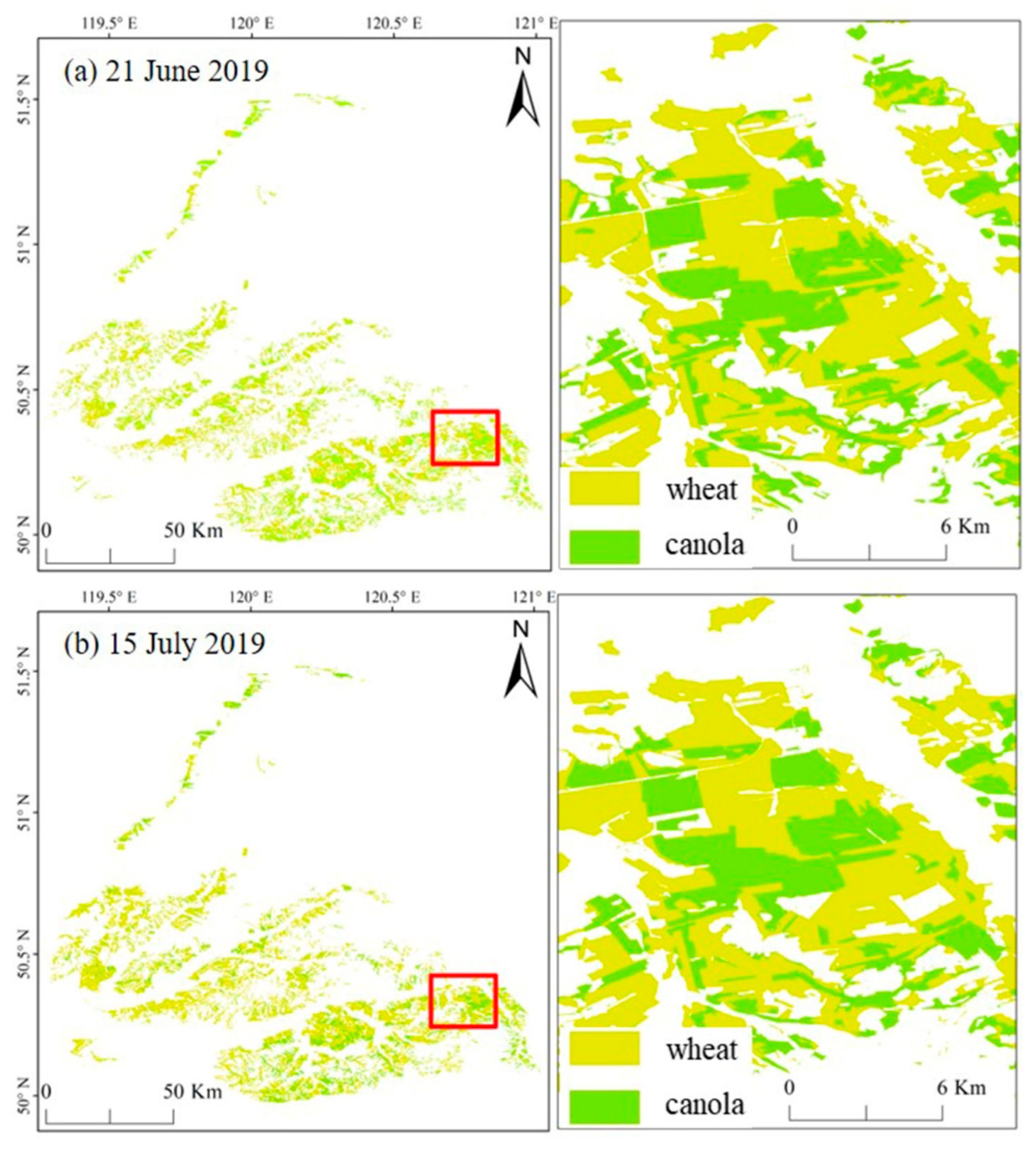


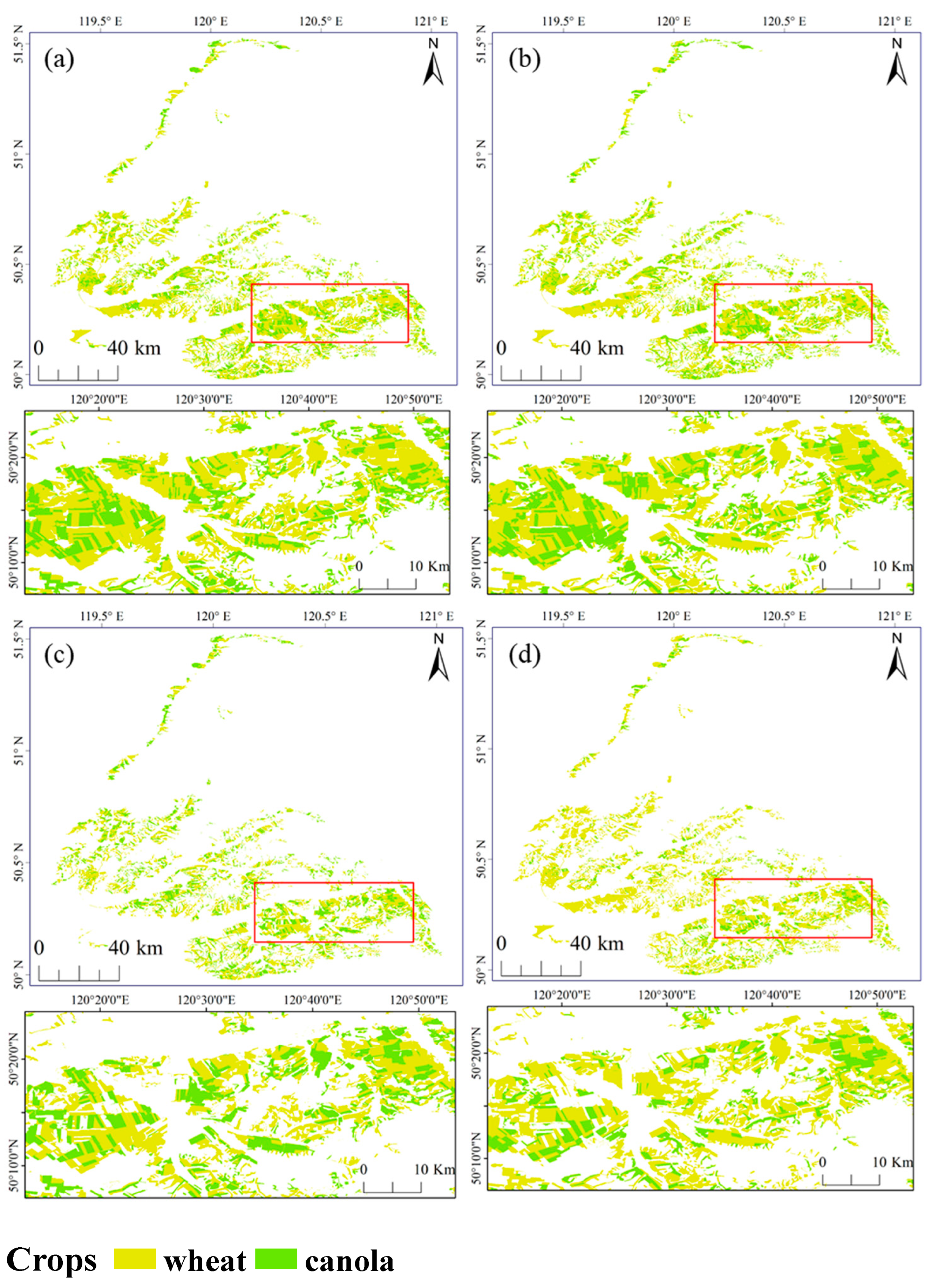

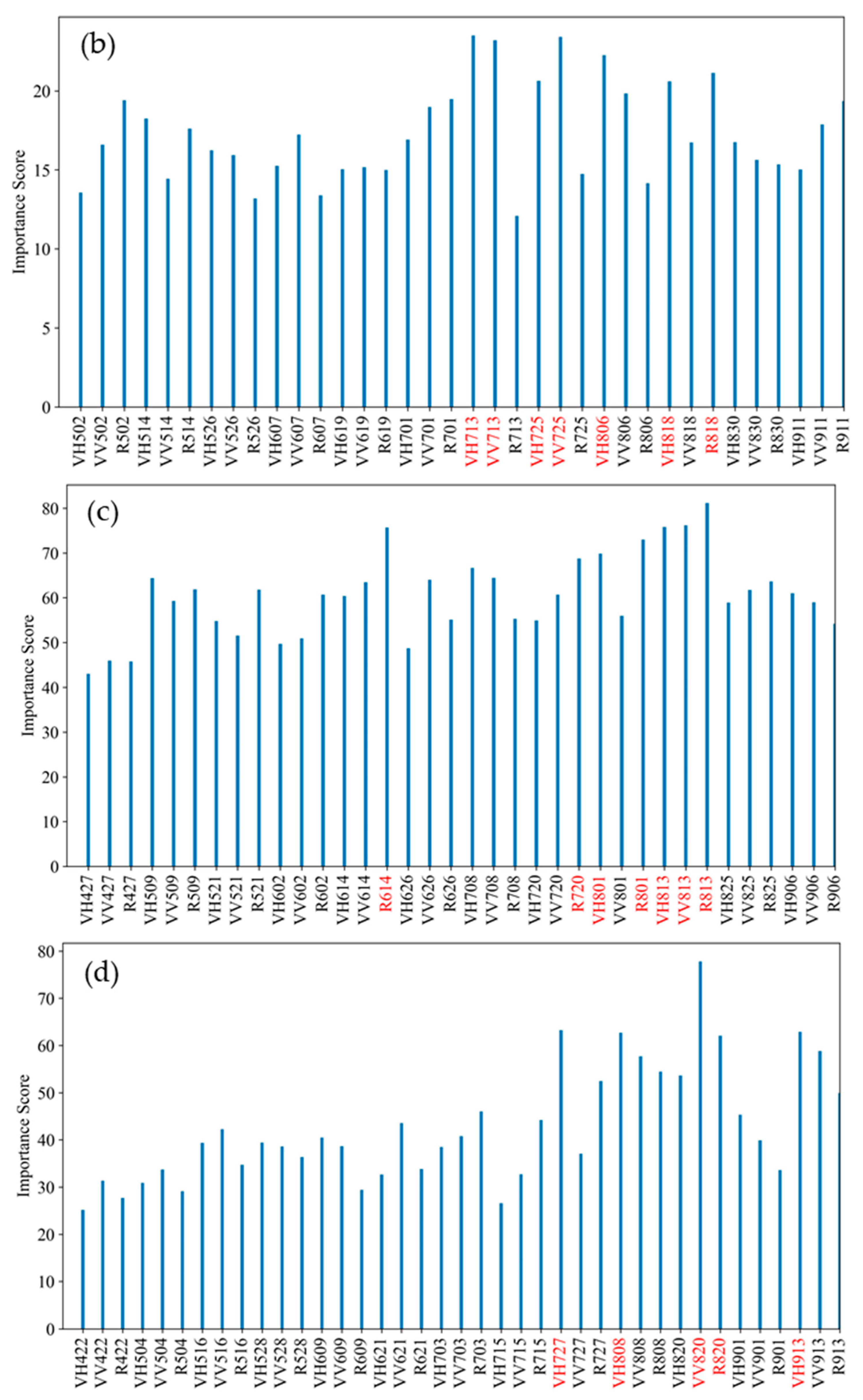
| Year | Mode | Polarization | Date of Acquisition | Orbit | Incidence Angel (°) |
|---|---|---|---|---|---|
| 2016 | IW | VV + VH | 19 Apr., 1 May, 13 May, 25 May, 6 Jun., 30 Jun., 12 Jul., 24 Jul., 5 Aug., 17 Aug., 29 Aug., 10 Sep. | Descending | 36–44 |
| 2017 | IW | VV + VH | 2 May, 14 May, 26 May, 7 Jun., 19 Jun., 1 Jul., 13 Jul., 25 Jul., 6 Aug., 18 Aug., 30 Aug., 11 Sep. | Descending | 36–44 |
| 2018 | IW | VV + VH | 27 Apr., 9 May, 21 May, 2 Jun., 14 Jun., 26 Jun., 8 Jul., 20 Jul., 1 Aug., 13 Aug., 25 Aug., 6 Sep. | Descending | 36–44 |
| 2019 | IW | VV + VH | 22 Apr., 4 May, 16 May, 28 May, 9 Jun., 21 Jun., 3 Jul., 15 Jul., 27 Jul., 8 Aug., 20 Aug., 1 Sep., 13 Sep. | Descending | 36–44 |
| 2016 | 2017 | 2018 | 2019 | ||
|---|---|---|---|---|---|
| Wheat | Number of Fields | 206 | 252 | 223 | 255 |
| Area (ha) | 4551 | 4937 | 4873 | 5369 | |
| Canola | Number of Fields | 97 | 147 | 190 | 137 |
| Area (ha) | 2767 | 2781 | 4335 | 2148 |
| Year | Wheat | Canola | OA | Kappa | |
|---|---|---|---|---|---|
| 2016 | PA | 0.96 | 0.91 | 0.94 | 0.87 |
| UA | 0.94 | 0.92 | / | / | |
| F1 | 0.95 | 0.92 | / | / | |
| 2017 | PA | 0.94 | 0.97 | 0.95 | 0.90 |
| UA | 0.98 | 0.90 | / | / | |
| F1 | 0.96 | 0.93 | / | / | |
| 2018 | PA | 0.95 | 0.97 | 0.95 | 0.93 |
| UA | 0.95 | 0.97 | / | / | |
| F1 | 0.95 | 0.97 | / | / | |
| 2019 | PA | 0.96 | 0.95 | 0.96 | 0.94 |
| UA | 0.98 | 0.93 | / | / | |
| F1 | 0.97 | 0.94 | / | / |
Disclaimer/Publisher’s Note: The statements, opinions and data contained in all publications are solely those of the individual author(s) and contributor(s) and not of MDPI and/or the editor(s). MDPI and/or the editor(s) disclaim responsibility for any injury to people or property resulting from any ideas, methods, instructions or products referred to in the content. |
© 2023 by the authors. Licensee MDPI, Basel, Switzerland. This article is an open access article distributed under the terms and conditions of the Creative Commons Attribution (CC BY) license (https://creativecommons.org/licenses/by/4.0/).
Share and Cite
Zhao, L.; Wang, S.; Xu, Y.; Sun, W.; Shi, L.; Yang, J.; Dash, J. Evaluating the Capability of Sentinel-1 Data in the Classification of Canola and Wheat at Different Growth Stages and in Different Years. Remote Sens. 2023, 15, 2731. https://doi.org/10.3390/rs15112731
Zhao L, Wang S, Xu Y, Sun W, Shi L, Yang J, Dash J. Evaluating the Capability of Sentinel-1 Data in the Classification of Canola and Wheat at Different Growth Stages and in Different Years. Remote Sensing. 2023; 15(11):2731. https://doi.org/10.3390/rs15112731
Chicago/Turabian StyleZhao, Lingli, Shuang Wang, Yubin Xu, Weidong Sun, Lei Shi, Jie Yang, and Jadunandan Dash. 2023. "Evaluating the Capability of Sentinel-1 Data in the Classification of Canola and Wheat at Different Growth Stages and in Different Years" Remote Sensing 15, no. 11: 2731. https://doi.org/10.3390/rs15112731
APA StyleZhao, L., Wang, S., Xu, Y., Sun, W., Shi, L., Yang, J., & Dash, J. (2023). Evaluating the Capability of Sentinel-1 Data in the Classification of Canola and Wheat at Different Growth Stages and in Different Years. Remote Sensing, 15(11), 2731. https://doi.org/10.3390/rs15112731









